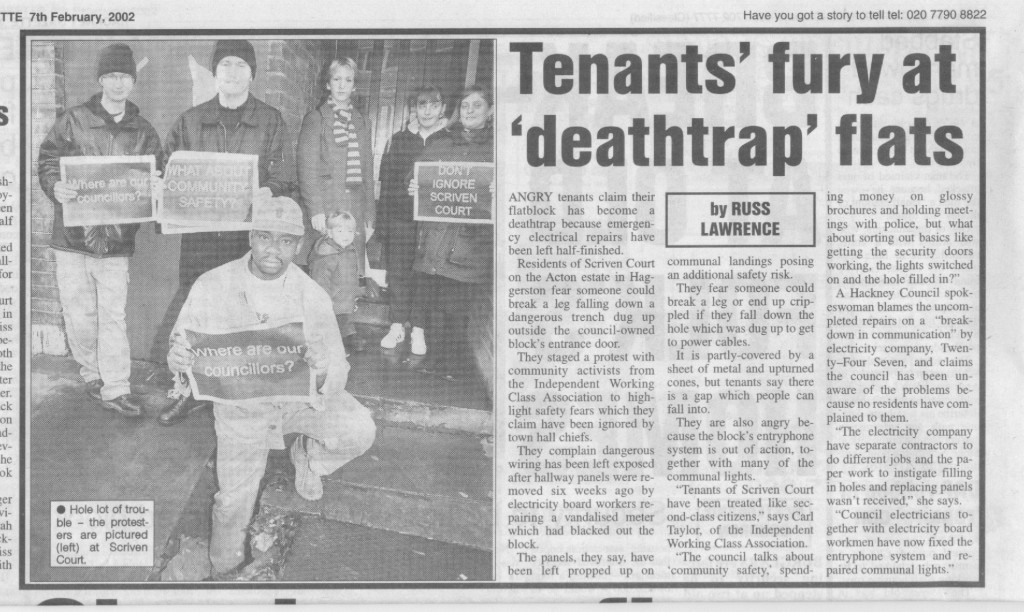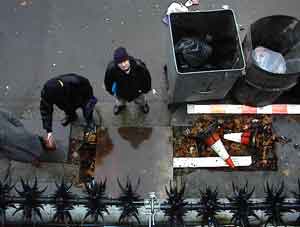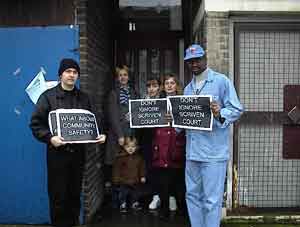Portraits from Well Street
Posted: February 23, 2002 Filed under: Gentrification / Regeneration Comments Off on Portraits from Well StreetPaul Mattsson is a local photographer who has worked closely with traders and residents on Well Street Market in Hackney, a street that has resisted the gentrification which is sweeping East London.
Paul’s exhibition of photos is being held in a shop at 230 Well Street until 1st April (12pm – 6pm daily, 7 days a week). The exhibition will be attended at all times by either Paul Mattsson or one of the contributing photographers. For more details contact Paul on 07940 576880/020 8985 9609 or write to 205 Well Street, Hackney, E9 6QU.
The Great Hackney Pitch Sell-Off
Posted: February 19, 2002 Filed under: Hackney Council Comments Off on The Great Hackney Pitch Sell-Offby Keith Dovkants
related stories:
*What Hackney Council can’t do
*The long list of broken promises
*The men who failed the voters
The great Hackney pitch sell-off
These all-too-scarce open spaces are vital lungs in a part of the inner city where light and air are at a premium. They are places that children, especially, need. But Hackney council is about to sacrifice them to the cause of trying to balance its books.
How could it come to this? The answer goes back decades, to the ideological blight of the Loony Left, factional in-fighting and corruption scandals that steadily bled the life out of the borough. Last May the council was taken over for the first time by New Labour. A group of moderates, led by a committed Blairite, Jules Pipe, promised a new beginning. But an Evening Standard investigation shows services have deteriorated still further and the financial position is at crisis point.
All this has happened despite massive sell-offs, a 10 per cent hike in council tax and cuts so severe Hackney is on the brink of failing in its statutory duties.
Nick Raynsford, Local Government Minister, promised last month to give the council £25 million of taxpayers’ money to shore up essential services. But even this – equivalent to almost £130 for every one of the borough’s 192,479 residents – is at risk of sliding into the bottomless pit that has swallowed countless millions.
The word countless is used advisedly. It is to Hackney’s enduring shame that during the past year it has doled out enormous sums without a shred of supporting documentation. Money has simply disappeared, money that was desperately needed. Where did it go?
Auditors did a check on a random sample of 47 individuals being paid from the £200million annual payroll. Employee files could only be found for 12 of the 47. They checked arrangements with outside contractors. On one £8million deal the council’s monitoring team couldn’t find the contract so no one was sure what they were supposed to get for the money.
In the bad old days of the Loony Left, Hackney was known as a soft touch for employees seeking pay-offs. In the past year two members of council staff hit on a way of streamlining this often onerous process. They made themselves redundant.
All over the borough people are feeling the squeeze. Among the worst affected are families with young children, hit hard by the closure and disposal of child and nursery facilities. The latest threat is to concessionary travel for the disabled.
The sale at Claridge’s is part of a mass disposal of assets which the New Labour council boasted would raise a potential £70 million. By November last year only £10million had been realised.
The council sought to reassure a government monitoring team and the auditor by saying further buildings and land it planned to sell this winter would bring in £ 30million. Expert opinion suggests this figure is wildly optimistic-It is believed the promised £70million could amount to no more than £30million, leaving a gaping £40million hole in the asset disposal budget.
Residents’ anxieties over the sale of assets are shared by district auditor Les Kidner. He has cautioned the council against wholesale disposals because it will need properties for future regeneration and ” unidentified future needs”. But the future seems to be the least of the council’s concerns as it pursues a hand-to-mouth existence.
For many Londoners, Hackney has long been thought of as another planet, an alien place best left to fend for itself. But no one can feel insulated from the unfolding tragedy that threatens to engulf it. Other London boroughs are already being asked for an extra £700,000 to make up a shortfall in Hackney’s contribution to the Mayor’s budget.
And it may be only a matter of time before the taxpayer is asked to pay for a rescue operation on an unprecedented scale.
Hackney has a debt of more than £700million that dates back years. It is costing around £30million a year to service and local action groups are about to launch a campaign that will call on the Government to write off the debt. If it can be done for developing countries, they say, it should be done for Hackney.
The Government is unlikely to set a precedent that will have prudent local authorities up and down the country crying foul, but there is a growing belief in Whitehall that the Hackney crisis will only be resolved with yet more handouts from the public purse.
While Hackney’s playgrounds were being selected to go under the hammer, the Labour group was agonising over one of its pet projects, a £600,000 scheme to create a landscape garden outside the town hall in Mare Street.
After months of pressure from opposition councillors and residents, this idea has now been dropped.
The men who failed the voters
Posted: February 19, 2002 Filed under: Hackney Council, Labour Party, Nurseries Comments Off on The men who failed the votersHe says he needs time to sort out Hackney’s problems, but many residents are unimpressed by what they have seen so far and Mr Pipe’s majority of five may evaporate in this May’s elections.
His popularity took a sharp dive when he personally intervened to halt a sit-in by parents at two popular nursery schools threatened with closure in a round of spending cuts. One parent said: “He gave us to understand that the schools would not be closed and we called off the occupation.” Soon after, both nurseries were shut and offered for sale.
Mr Pipe has given stalwart support to Hackney’s managing director Max Caller, known widely throughout the borough as “Mad Max”. Mr Caller was the former chief executive at Barnet and applied for the Hackney job after reading an advertisement which warned applicants that Hackney had “an absence of coherent political leadership, a disconnection between strategy and operation, poor financial management and a lack of focus on basic services”.
Mr Caller, who earns £150,000 a year, says he is doing his utmost to tackle these problems, although many feel his best is not good enough. When he turned 50 last summer, a group of Hackney residents arrived at the town hall with a birthday card that suggested he take early retirement.
According to town hall lore, he is preoccupied by concerns over his personal security after a number of threats. He has a secure car parking space and an elaborate alarm system at his home that is said to have cost the council £40,000.
Shoreditch Tenants – Being Realistic?
Posted: February 17, 2002 Filed under: Gentrification / Regeneration, Shoreditch, Tenants & Residents Associations Comments Off on Shoreditch Tenants – Being Realistic?Hackney IWCA (Hackney Independent as of summer 2004) member and Chair of Wenlock Barn tenant association, Tony Butler replies to Housing Minister Lord Falconer’s comments that Shoreditch tenants need to be “realistic” as reported in the Guardian on February 14th.
To respond to Lord Faulkers comments “the community need to be realistic” because we choose to have our homes refurbished rather than knocked down – Reported in your article (Flagship scheme under threat) 14 February.
The opposition in Shoreditch to demolition is based on sound reasoning as we know it is backdoor privatisation. No new build homes in Hackney have been council homes. Redeveloped estates Hackney never have the same amount of social homes as before demolition and tenant returnee rates have been abysmally low.
The fact is there is a homeless crisis in Hackney and London. Temporary decantees from demolition in Shoreditch are unlikely ever to return as the Council’s policy is to house those who are the destitute and most vulnerable as an absolute priority. Holly Street is the classic and typical example. Lauded by the PM and in Re-gen circles. 3000 homes demolished 2000 home new build, 800 RSL’s homes, and the rest open market sales. A report commissioned by London Borough of Hackney acknowledges only 1 in 10 tenants returned.
The change in the economic profile of the new residents in Holly Street has been celebrated as an added bonus. New Build, New people, and hey presto! The Government & Hackney has solved the social problems of poverty, deprivation. Simply by dispersing it. We don’t fancy being replaced with anyone including those middle income KEY WORKERS.
We know that talk of ‘Tenure diversification’ of working class areas is all the rage Re-gen circles. Its funny how they never talk about merits of Tenure diversification in Surbiton, Barnes, Hampstead, Buckinghamshire, the Home Counties or any other up market areas where they live. The bottom line is that gentrification/social cleansing is pushing working people out of inner London through the combination of Government/Local Authority housing polices and good old market forces.
Most people in Shoreditch know that they will never be able to afford, or be eligible for the Shiny new homes on offer after demolition; all we want is for our existing homes to be renewed.
That is being realist Lord Faulkner
Tony Butler
Wenlock Tenants and Residents Association
Shoreditch
Flagship Scheme Under Threat
Posted: February 17, 2002 Filed under: New Deal, Shoreditch Comments Off on Flagship Scheme Under ThreatThe scheme’s treasurer, Clayeon McKenzie, said: “We need communal land to develop the area. Our regeneration scheme is going to be dead in the water if they flog off any more land. All that we’ll be left with is the homes that we live in.”
The community-led project is particularly alarmed at the council’s decision to put a popular adventure playground on its disposal list. It has also been under pressure in the past to demolish council homes to make way for private development, which would force tenants out of the area.
The borough, which has debts of £50m, has already been warned against selling off council assets by the district auditor. The matter is now also being raised by local Labour MP Brian Sedgemore, who said he was “very concerned” about proposed land sales.
Speaking at a visit to Shoreditch yesterday, the regeneration minister, Lord Falconer, ducked the issue of sales. He said: “That is something that needs to be worked through by the new deal partnership and the council. One cannot avoid the financial pressures. One needs to find a solution that delivers a long term community programme for Shoreditch.”
In private discussions with Shoreditch Our Way, Lord Falconer is understood to have offered to forward some of the £22m earmarked for the project to improve housing in the area, so that it could buy off land from the council. The suggestion alarmed Mr McKenzie. He said: “That would be robbing Peter to pay Paul. That money is for improving the housing not bailing out Hackney council, it’s absurd.”
Last summer Lord Falconer withheld the housing cash because he rejected the community’s plans for improving the homes, claiming they were “unsustainable” and did not have the backing of Hackney council. At the time, both Hackney and the government were concerned that the resident-led project refused to consider demolishing some of the 7,000 council homes in the area.
Yesterday Lord Falconer said: “At that time we could not agree on what [the plans] should consist of. Since then there has been a productive relationship between Hackney council and the new deal partnership. “I don’t want to comment on the detail of whether there is too much council housing. I think the issue is what is a sustainable future for the housing problem?”
Lord Falconer reaffirmed that the government was “serious” about new deal projects being community led, but he added that the community needed to be “realistic”. Representatives from Shoreditch Our Way were keen yesterday to stress that they were now working with the council on new plans to improve the homes in the area. No one from the council attended Lord Falconer’s visit to underline that message. A Hackney spokeswoman said that staff were “very thin on the ground”.
The Deal – £25m From Government In Exchange For £13m Cuts And 10% Rise In Council Tax
Posted: February 13, 2002 Filed under: Hackney Council, ITnet, Privatisation / Sell Offs Comments Off on The Deal – £25m From Government In Exchange For £13m Cuts And 10% Rise In Council TaxIn response to the three-year budget strategy provided by Hackney Council last year, central government is to give the local authority £25m to reduce the impact of the cuts. The ‘deal’ still requires £13m worth of cuts and a 10% increase in council tax. Not much of a deal for Hackney residents who will be paying more whilst simultaneously watching their public services disappear.
How to balance the budget – whatever the social cost
After an audit commission report in 1999, huge gaps in the authority’s finances were exposed and central government demand-ed changes to the running of the council. The first step it took was to prevent a single penny from being spent, by serving a Section 114, an inadequate policy which saw waste vehicles sit idol in the depot waiting for repair as rubbish piled up on the streets. The ensuing protests forced the order to be lifted, but only after the council agreed to formulate a three- year budget balancing strategy. The government paid £3.5m to accountants whose task was to go through each department’s finances looking at ways to make savings.
When the strategy was publicly aired in December last year, there was outrage – no area within reach of the council was safe as group after group and service after service faced huge reductions in their finances. Many residents most in need, the young, elderly and those from minority communities, will lose vital facilities.
The budget strategy requires the government to give Hackney £54m over 3 years. However, it has now been made clear the only one year’s worth of extra funding will be offered. Will the future see even worse cuts imposed than those already outlined in the 3 year budget?
Drop the Debt!
The Government may wish to shift all the blame onto Hackney Council but a major part of the problem is the massive debt repayments the Council has to make to the Government – nearly £75 million each year. If it did not have to pay this it would not have to take the short-sighted step of selling off its family silver, in the form of buildings and land. The facilities that occupy these, such as libraries and play-grounds, are under constant threat of disappearing. The District Auditor has warned that property disposal ‘is not a sustainable medium-term strategy’ while, at the same time, asking for ‘clear actions and timescales to show how the gap (in future budgets) is to be addressed’.
Government-encouraged privatisation has also added to Hackney’s debt. The outsourcing of benefits and council tax to the company ITNET cost the borough £38m when the deal went sour. ITNET meanwhile announced a pre-tax profit for the year of £12.5m. Outsourcing of abandoned vehicles collection is intended although £130,000 of the Neighbourhood Renewal Fund is to be used on it until that happens. And privatisation of Waste Management now seems likely to cost more than when it was in the hands of the council.
The Government claims that the £25m is ‘an exceptional offer of support to prevent unacceptable cuts in services’. Yet £13m cuts are totally unacceptable and more will be scheduled for next year. The Government has provided stringent conditions attached to the money. At least £10m must be made available for future years and so is not available for services at all.
Once again the people of Hackney are left dangling on a thread wondering about the future of their community and what next year’s budget will bring.
News from Hackney Not 4 Sale
Hackney Not 4 Sale, Box No. 7, 136-138 Kingsland High Street, London, E8 2NS. Tel: 07950 539 254.
Tenants' fury at 'deathtrap' flats
Posted: February 7, 2002 Filed under: Community Safety, Media Comments Off on Tenants' fury at 'deathtrap' flats






Recent Comments